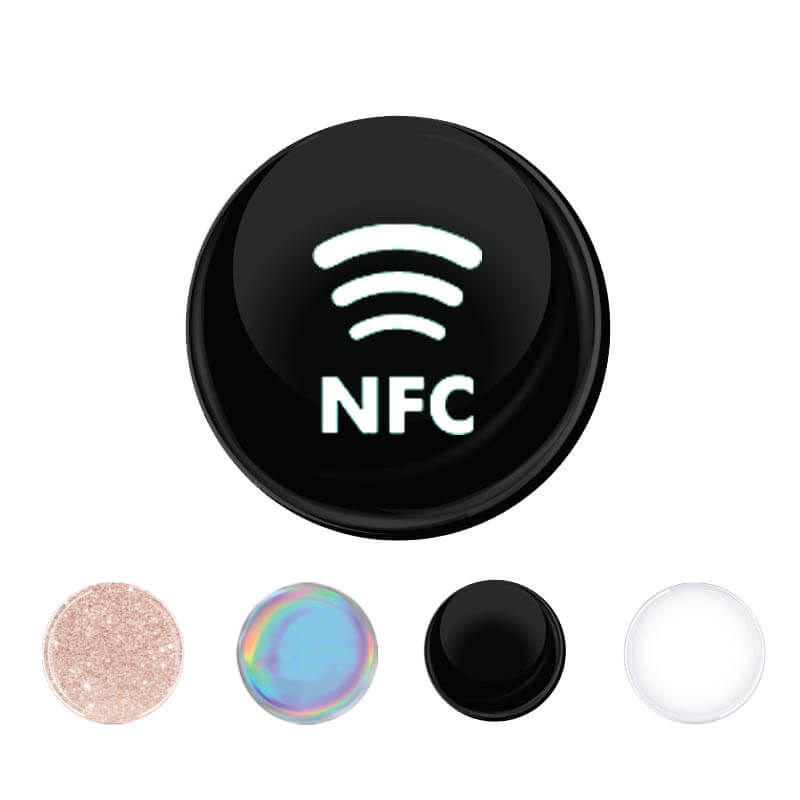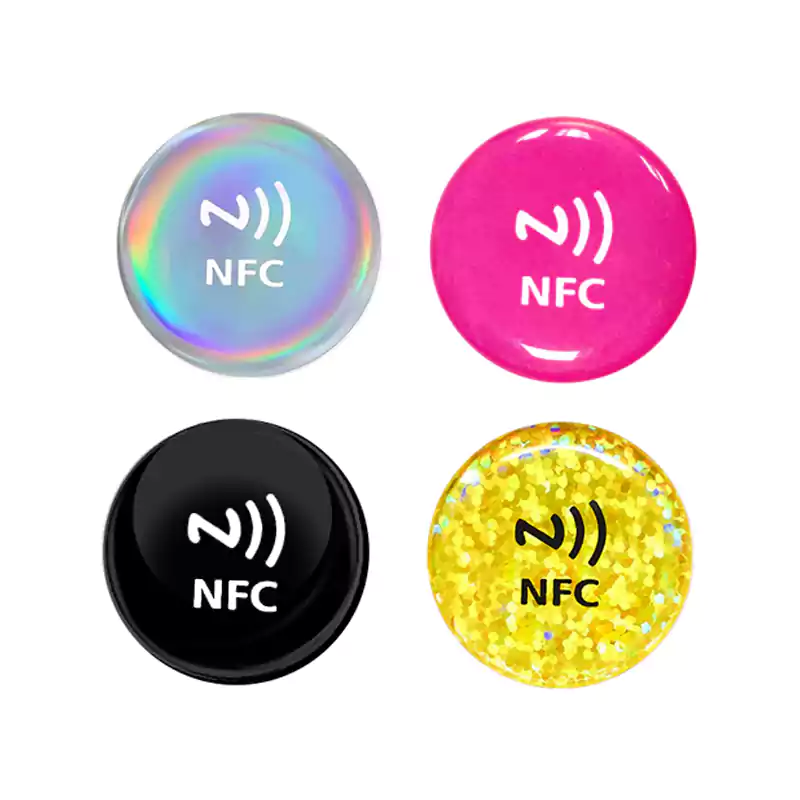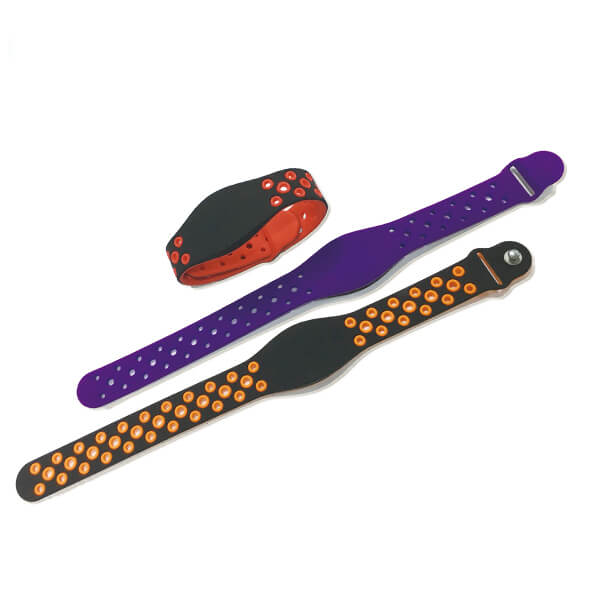NFC is an acronym for Near Field Communication. It uses short-range radio waves to share and receive data wirelessly between an NFC reader and an NFC tag.
An NFC chip is small and must be embedded in a carrier. Manufacturers use different carriers, including cards, key fobs, wristbands, phones, and bracelets.
Whenever the NFC tag comes close to a reader (approximately 4 inches), it is excited by its magnetic waves. This results in data release in form of signals. If you’re still not sure how NFC works, then this article is for you. Read on.
A Brief History of NFC
NFC Technology was developed in the early 2000s by Sony and Philips. It is based on radio-frequency identification (RFID), a related technology that has been employed for years to identify items using radio waves, such as pets or warehouse supplies.
NFC uses what is called “near field” communication because it only works when the communicating devices are very close together — no more than a few inches apart.
Different types of NFC devices include contactless tags, cards, key fobs, stickers, and smartphones. The two main standards used by NFC are called “NFC-A” (for Android) and “NFC-B” (for BlackBerry). Besides type A and type B, several other types of NFC technology exist. They include NFC-FeliCa and NFC-V.
The difference among these types is in the communication speed and the range, but all of them use radio waves to communicate. They also may differ slightly in the method applied for data storage and exchange.
Components of NFC Technology System
There are 3 main components of this technology:
- Reader or Initiator
- Writer or Target
- Card or Tags
The Initiator is the NFC reader, it will read and write information to the target. It converts radio waves into digital bits and vice versa by emitting its electromagnetic field and receiving incoming waves from another device.
The writer or target receives commands from an initiator and stores the data in a secure key that is only accessible to the target. This ensures that data can’t be stolen or modified.
An NFC chip is embedded into a card/tag, which allows users to access applications or send data with a simple touch of their smartphone on another NFC-enabled device (e.g., door, ticket). By using this technology, the smartphone can read and write data by using NFC tags.
NFC tags look like tiny stickers and can store both large and small amounts of information. Examples of information that can be stored include such as product details, log-in credentials, website URLs, and contact information.
How Does NFC Work? A Detailed Analysis
Magnetic induction is the underlying mechanism of Near Field Communication (NFC). This implies that a wire will release energy waves that are perpendicular to the wire when an alternating current is carried across it. They fluctuate or move quickly back and forth between two terminals and are known as electromagnetic fields.
At 13.56 MHz, an NFC chip generates radio waves. The signals are wirelessly sent when the waves cross the antenna of an NFC reader.
Mutual induction, when two magnetic fields interact, allows for the transmission of information. An initiator is a device that emits electromagnetic waves, while a target is a device that receives those waves.
The target device will have a coil of wire, which can be recharged with energy from the other device as it absorbs electromagnetic waves. The chip inside it transmits its ID number and also receives data from the reader via radio waves.
Since both devices are wireless, they can be used to communicate with each other without having to connect via cables or wires. The communication between them is in the following format: EXECUTE_TRANSFER. This means sending data from the initiator to receive data at the target. For NFC devices to work, they must adhere to a set of standards developed by the NFC Forum as discussed below:
NFC Technology Standards
Originally, NFC was regulated by ISO/IEC 18092 (NFCIP-1). However, the regulations were extended to include ISO/IEC 21481 (NFCIP-2). This also added ISO/IEC 15693 and ISO/IEC 14443, which guarantees a seamless use of radiofrequency communication in functions such as data exchange and logistics management.
In 2004, NXP formed a standardization group known as NFC Forum after the establishment of NFCIP-1. It also incorporated Sony Corporation and Nokia Corporation for a flawless integration of the technology on mobile devices.
The NFC forum formulated more regulations that would allow manufacturers to produce items that match the NFC Forum specifications. This guaranteed compatibility among devices, thus ensuring that both parties get optimum benefits from the technology.
Several of the NFC Forum Standards include:
- NFC-A and NFC- B. These standards conform to the ISO/IEC 14443 regulations on contactless IC cards. It ensures that user data is protected whenever an exchange occurs.
- NFC-F. This standard is also known as FeliCa communication technology. It was developed in compliance with JIS X 6319-4 and ISO/IEC 18092 international standards.
- NFC-V. NFC Forum developed this standard based on the requirements of ISO/IEC 15693 wireless communication between devices.
The primary role of this standardization is to ensure the compatibility of all international communication devices. This way, users will be able to use one technology with products from another company.
Additionally, NFC is compatible with other wireless technologies such as Bluetooth and Passkey Entry. With these compatibility levels, users can access a wider range of functions using their NFC-enabled phones.
How Is the Information Transferred?
Information is exchanged via electromagnetic waves with NFC technology. This makes it possible for devices with low power consumption to communicate without the need for physical cords or wires. NFC is regarded as a high-frequency technology since it uses a frequency of 13.56 MHz.
NFC tags are discreet and work with the majority of smartphones. An NFC tag most frequently takes the shape of a sticker, which may be applied to any surface. They come in a variety of sizes and forms to accommodate various needs, some being bigger than others to accommodate more data.
The most typical NFC tag is a small, 2 cm by 2 cm sticker that may be applied to any surface, including the screen of a smartphone, a piece of clothing, or a poster. By simply waving your mobile device over the tag and sending the information you wish to communicate, you may share these tags with other people.
Paper or plastic NFC stickers have a printed circuit with an NFC chip, an antenna, and batteries for powering them on one side. For adhering to surfaces, the reverse side of the material is occasionally coated with an adhesive coating.
Applications of NFC Technology
Peer-to-peer data transmission is a kind of communication that NFC technology uses to connect smartphones and other devices.
Users now have access to a higher degree of connection that may be utilized for booking tickets, making purchases, and socializing. Below is a thorough breakdown of several NFC applications:
- Payments
NFC payments are made by tapping a credit or debit card that supports NFC and leaving the store. The procedure is straightforward, and the user is not required to key in any information such as CVC numbers.
To use an NFC terminal, users only need to tap their mobile smartphone against it. It will instantly recognize the data kept on the device and finish the transaction.
- Peer-to-Peer Data Exchange
Sending and receiving files between devices is accomplished by NFC peer-to-peer data transmission. This kind of information transmission can be set up as a share action (Android) or via the use of an application like Android Beam (iOS). The procedure is easy;
Simply choose the file to transfer, touch the sending device against the receiving device, and then wait for it to finish.
- Ticketing
Moviegoers can use an application called NFC ticketing to enter a cinema by tapping their smartphones on specialized NFC scanners located at the theater’s entrance. Carrying tickets or worrying about losing them is no longer necessary.
The technology has also been used to control tickets in the public transportation industry. This increases effectiveness and gets rid of delays that would cause enormous costs.
- NFC-Enabled Passports
Towards the end of 2006, the U.S. Department of State introduced the National Passport Card with Near Field Communication technology. This effort makes it simpler for consumers to go abroad or conduct financial transactions abroad by giving them access to their passport data via a tap-and-go device.
The technique is being used by other nations as well for security reasons. Governments can monitor visitors’ movements when they use NFC-enabled passports. It eliminates the possibility of criminals entering the nation covertly.
- Automated Hotel Processes
By utilizing NFC technology, several hotels and resorts have automated their check-in and check-out procedures. The procedure is easy:
Tap the desired device against the terminal after choosing it, then follow the on-screen instructions.
- Social Networks
Through social networking, keeping in touch with pals around the world is simpler than ever. NFC makes it simpler to exchange photos and listen to music concurrently with others.
- Mobile Phones
Many top smartphone makers have been integrating NFC capabilities onto their smartphones due to their low battery consumption; this enables
- Public Buildings & Event Venues
With only one touch of the user’s smartphone, NFC scanners deployed in public buildings and event sites offer safe entry management. This eliminates the need for visitors to carry physical admission cards, making it easier to access and exit these facilities.
- Ticketing Machines & Service Kiosks
In order to swiftly swipe their cards against the terminal, clients may easily utilize NFC in ticketing machines and service kiosks. By demanding authentication via PIN numbers or biometrics, it ensures security.
- Retail Stores
Customers won’t have to manually enter their payment information into the terminal each time they make a purchase thanks to the usage of NFC for contactless payments. The consumer experience at retail establishments is considerably improved by this. Retailers may also utilize NFC tags to conduct customized promotions and exclusive offers on their goods or services, enabling
Benefits of NFC Compared to Other Wireless Technologies
NFC has a lot to offer over traditional wireless technologies such as Bluetooth and Wi-Fi. Here’s a comparison:
- Proximity Connection Distance. Your mobile device can connect to another device via NFC only at close ranges (maximum distance of 10 cm). Because of its peer-to-peer connection, which automatically couples devices at close range, NFC does not have a range issue.
- Connecting to Other Devices. Wireless data communication between your phone and other devices is made possible via NFC. To connect to other devices, Bluetooth and Wi-Fi need the usage of specialized adapters.
- Ease of Use. NFC is quite simple to use and doesn’t need any specialized knowledge or abilities from the user. Anybody can utilize the technology with minimal effort since it is so straightforward. Learn more about the use of NFC.
- Security. Compared to conventional payment methods, NFC adds an extra degree of security because each user is required to verify their identity using a special PIN code or biometrics. This implies that even if a person were to get access to the device, they would not be able to use the data that was saved without the proper credentials.
- Cost. When it comes to setup costs, NFC is far less expensive than Bluetooth or Wi-Fi technologies since it uses a low-power radio frequency communication technique. By utilizing these capabilities, businesses may reduce overhead costs without having to invest in expensive additional equipment.
- Convenience. Payments are now quicker and easier than ever before thanks to NFC, which eliminates the need for customers to manually enter their payment information into the terminal every time they make a purchase. Also, it makes it simple for users to instantly interchange data between apps on various platforms without having to manually enter any additional data.
- Versatility. The range of applications that can be enabled with NFC is constantly expanding due to its flexibility and scalability; this covers both real-world uses such as contactless payments, but also more creative uses like digital keys or access control at public buildings and event venues.
- Accuracy. With its short-range capabilities, NFC ensures accuracy in transactions as there is no chance of interference from devices outside the communications range; this helps reduce fraud risks while preventing errors in customer data entry when making payments or sharing sensitive information between devices/readers quickly and securely.
Differences Between NFC and RFID
NFC and RFID technologies are both wireless communication methods that are commonly used in various applications. RFID vs NFC, Let’s compare their differences:
- Range: Compared to NFC technology, RFID technology has a greater range. Active RFID tags can be read from up to 100 meters away, whereas passive RFID tags can only be read from a few meters away. The range of NFC, on the other hand, is up to 10 centimeters.
- Data Transfer Rate: Compared to RFID technology, NFC technology transfers data more quickly. NFC can transport data at a rate of up to 424 kbps, whereas RFID can transfer data at a rate of up to 200 kbps.
- Power Source: Depending on whether they have their own power source or not, RFID tags can either be passive or active. NFC tags are constantly inactive and depend on the reader’s power to function.
- Security: NFC technology is more secure than RFID technology in terms of security. While RFID technology lacks encryption, NFC technology does.
NFC vs. Bluetooth – What’s the Difference?
NFC and Bluetooth have a lot in common. They both use radio waves at close range to connect devices. However, there are some significant differences between the two technologies:
- Range. Due to its short range, NFC technology may instantly link devices for quick data transfer (approximately 10 cm). As Bluetooth has a greater range, more devices can connect at a distance (up to 10 meters).
- Security. Bluetooth is less secure than NFC. NFC technology has security built in, enabling each device to encrypt the data it transmits. Even if hackers were able to intercept your information, encryption would prevent them from decrypting it.
- Transfer Speed. Bluetooth was not designed for mobile devices, therefore data may be carried more quickly via it. NFC transmission speeds are substantially slower than Bluetooth because NFC devices have extremely limited data transfer and reception capabilities.
- Operating Frequency. Bluetooth operates at 2.45 GHz, while NFC operates at 13.56 MHz. This makes NFC the preferable option for mobile devices since it can send and receive more data more quickly.
Platforms that Support NFC
Major corporations like Google, Apple, Microsoft, and Sony are all attempting to incorporate NFC into their products as the technology has gained popularity in the United States and across the world. Today’s majority of Android phones enable NFC for quick data transmission across various devices. The iPhone 6 and iPhone 6 Plus enable NFC, which will please iPhone users.
Modern smartcards, bank cards, passports, transit cards, smartphones, computers, and other consumer electronics gadgets all have NFC.
NFC’s Future Potential
Smartphones are turning into regular household items, thus NFC will probably stay a part of them. Eventually, due to this integration, NFC will be accepted almost everywhere as a speedier payment method for goods and services.
There is a potential that NFC will be employed in the future for more important purposes, such as facilitating electronic payments devoid of credit cards. In addition to raising security issues, this might fundamentally alter how we do social interactions.
Nowadays, NFC is implemented into millions of POS terminals. In the next five years, there are expected to be more than 1.4 billion smartphones with NFC capabilities.
With these figures, it is clear that NFC has a promising future. Technology will proliferate and be employed in society by an increasing number of individuals.
Related articles:
- What is the NDEF format?
- How to Program NFC Tags– Android and iOS
- The Reason Why Everyone Love NFC Wristband
- How to Create Your Own Amiibo Card in 3 Simple Steps
- 5 NFC Forum Tags Tyeps You Need to Know
- What is NFC Payment And How Do It Work?
- NFC Tags: Your Ultimate Guide
- How to Program NFC Tags to Connect to Wi-Fi?











